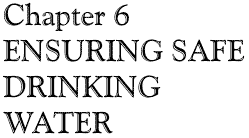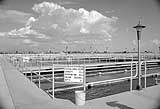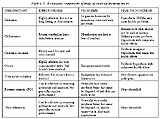
| ch. 6, pp. 69 - 71 |
A well-designed, installed and maintained septic system can be highly effective in treating household wastewater. Conversely, a poorly designed, installed or maintained system can contribute to local groundwater pollution and can be a health hazard. This is especially true in areas with shallow groundwater. Not much information is available to determine if septic tanks in the Tucson area are in fact causing pollution problems. Evidence exists, however, that septic fields often impact drinking wells in rural areas of the state.
A traditional septic system consists of a septic tank — which receives all of the waste water from sinks, toilets, tubs, etc.—and a drainfield. Wastewater first collects in the tank, where solids are allowed to settle and break down through natural bacteriological processes. The liquid in the tank drains into a series of perforated pipes from which it percolates through gravel, sand and other permeable materials. As the liquid drains through the soil, remaining pathogens are filtered out and broken down by bacteria and other organisms in the soil. Exceeding the capacity of the septic system is one of the most common ways systems fail. High water-use appliances and leaky faucets can cause problems, as can heavy rains. If the soils are constantly saturated, the efficiency of the microbial activity is reduced. Other situations that result in septic problems include failure to expand the septic system when the house it serves is expanded. Even short-term stresses such as visitors can overload a septic system. Though an overloaded system may show itself in slow drains or sewage backups, a failing system may simply result in incomplete treatment of the waste. Viral contamination, and nitrate and phosphate “plumes” can jeopardize nearby wells. This is particularly troubling since many of the Tucson homes on septic systems also have their own drinking wells. Failure to have settled solids in the tank pumped out every few years can let solids pass to the drainfield, clogging the system. Additional concerns include; soil compaction from vehicles driving over the drainfield; common household chemicals such as toilet bowl cleaners killing the microbes responsible for breaking down the waste; and lint from washing machines failing to settle in the tank, and then clogging the drain pipes. A further concern is septic tank owners adding solvents to dissolve plugged leach fields. This puts harmful chemicals into the soil. CENTRAL TREATMENT VS. INDIVIDUAL SYSTEMS Centralized treatment generally offers better control over water quality than small or individual systems. Centralization also offers more opportunities to reuse or recharge wastewater or for recharge, although in some areas leachate from septic tanks may help recharge the groundwater. In the past, the county has had problems with small privately owned treatment facilities installed as part of a subdivision deteriorating once the subdivision is complete. Local policy discourages such facilities. On-site use of wastewater, however, can be an efficient way of reducing groundwater pumping, without the costs of building new pipelines and pumping the treated water to an outside facility. HEALTH RISKS OF VARIOUS POLLUTANTS
Water pollution can cause a wide range of health problems. Some of these problems show up within days or weeks after contaminated water is consumed (e.g., dysentery) while others may take years to develop (e.g., cancer) and still others appear in the next generation (e.g., birth defects). Cause and effect is more readily determined when the problem appears shortly after the water is used. When the problem surfaces after a long period of time, cause and effect is more difficult to establish. This is especially true in our mobile society, with people developing a disease at a location other than where they or their parents drank the contaminated water. Appendix B lists the major pollutants regulated by EPA under the Safe Drinking Water Act and their possible health effects. Providing Safe Water Most water providers throughout the nation treat their drinking water in some manner. The common methods are described below. Tucson Water chlorinates most of its water, primarily to provide protection as water flows through pipes and reservoirs. Water providers such as Metropolitan Domestic Water Improvement District (Metro Water) and Flowing Wells also chlorinate their water to prevent diseases caused by microbes. Since groundwater, which is relatively free of pathogens and other harmful substances, is the main source of drinking water in the area, the use of chlorine has been adequate to protect health. Because CAP water is from the Colorado River, a surface water source, more extensive treatment will be needed. Filtration and disinfection is required of all surface supplies or groundwater under influence of surface water. More opportunities exist for contaminants to get into open bodies of water than into groundwater.
|


